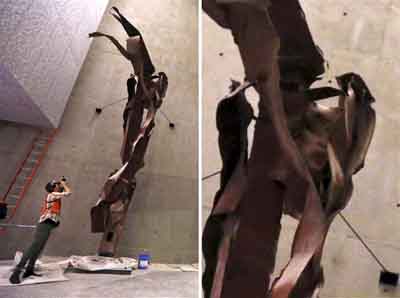
Photo:Mary Altaffer / AP
At left, a photographer takes a picture of "Impact Steel," a twisted girder from the North Tower of the World Trade Center that is now housed at the National September 11 Memorial and Museum. At right, a close-up of the girder highlights what appears to be a shadowy face within the metal.
From the right angle, construction workers at the National September 11 Memorial and Museum at New York's ground zero can make out a sad-looking face that's been dubbed the "Angel of 9/11," seemingly emerging from the twisted steel of a girder that was hit by the first hijacked plane. The facelike feature is the result of natural corrosion plus a trick of the eye — but that shouldn't make the angel any less inspiring.
The angel's dark eyes, nose and open mouth stem from a combination of factors, starting with the way the steel was twisted when American Airlines Flight 11 slammed into it on the morning of Sept. 11, 2001.
After the attack, salts, oxides and moisture on the steel's surface affected how the girder corroded, said P. Chris Pistorius, a materials scientist at Carnegie Mellon University who is co-director of the Center for Iron and Steelmaking Research. Air circulation around the ruined steel played a role as well.
"Atmospheric corrosion is very sensitive to microclimates," he told NBC News. "It's actually difficult to get even corrosion of such a surface. It's more likely to get a pattern than to get uniform corrosion."
If layers of steel are lying on top of each other, as appears to have been the case with the 9/11 girder, moisture can "wick in different areas and leave all kinds of different patterns," said Thomas Eagar, a professor of materials engineering at the Massachusetts Institute of Technology.





















